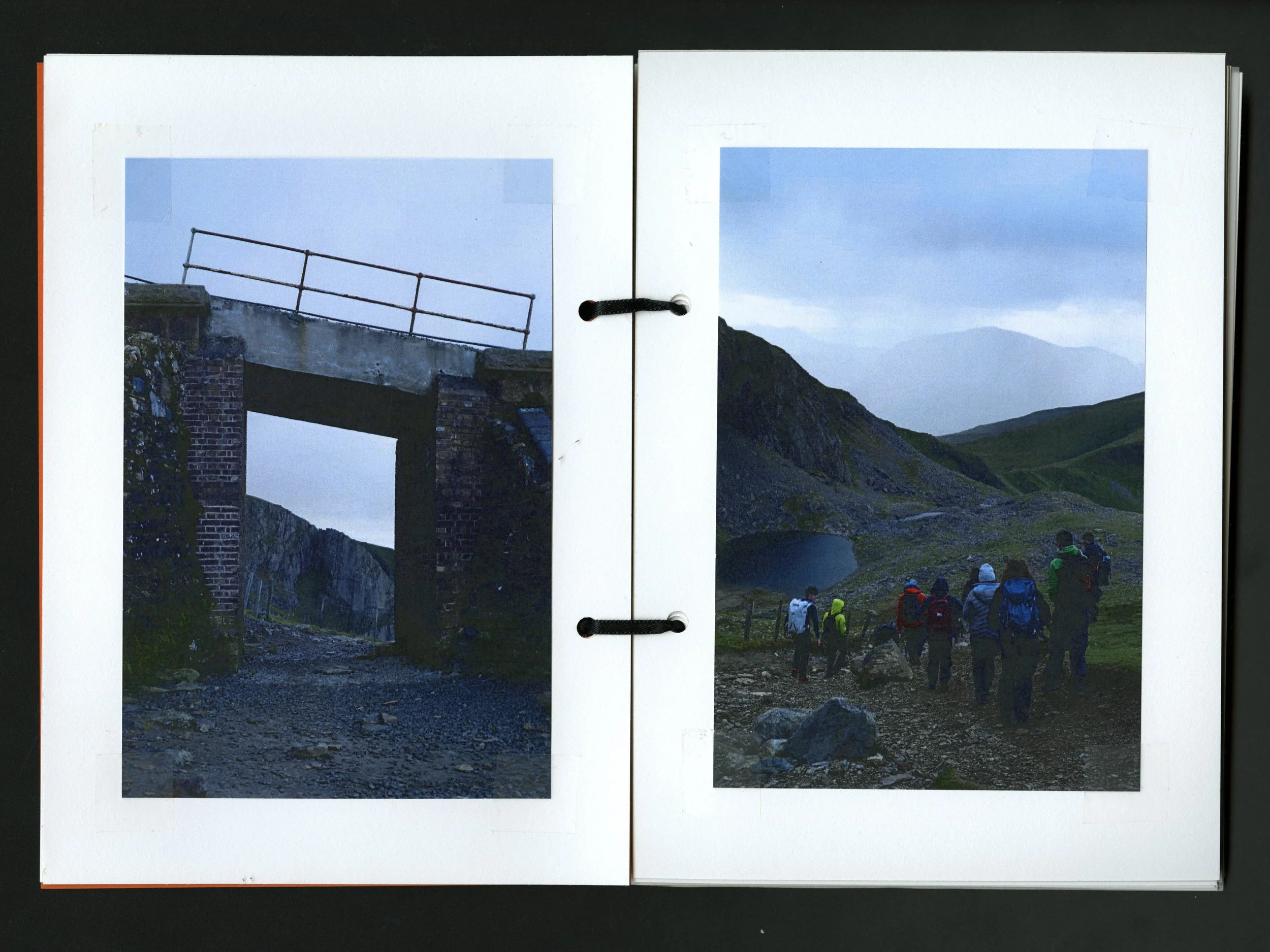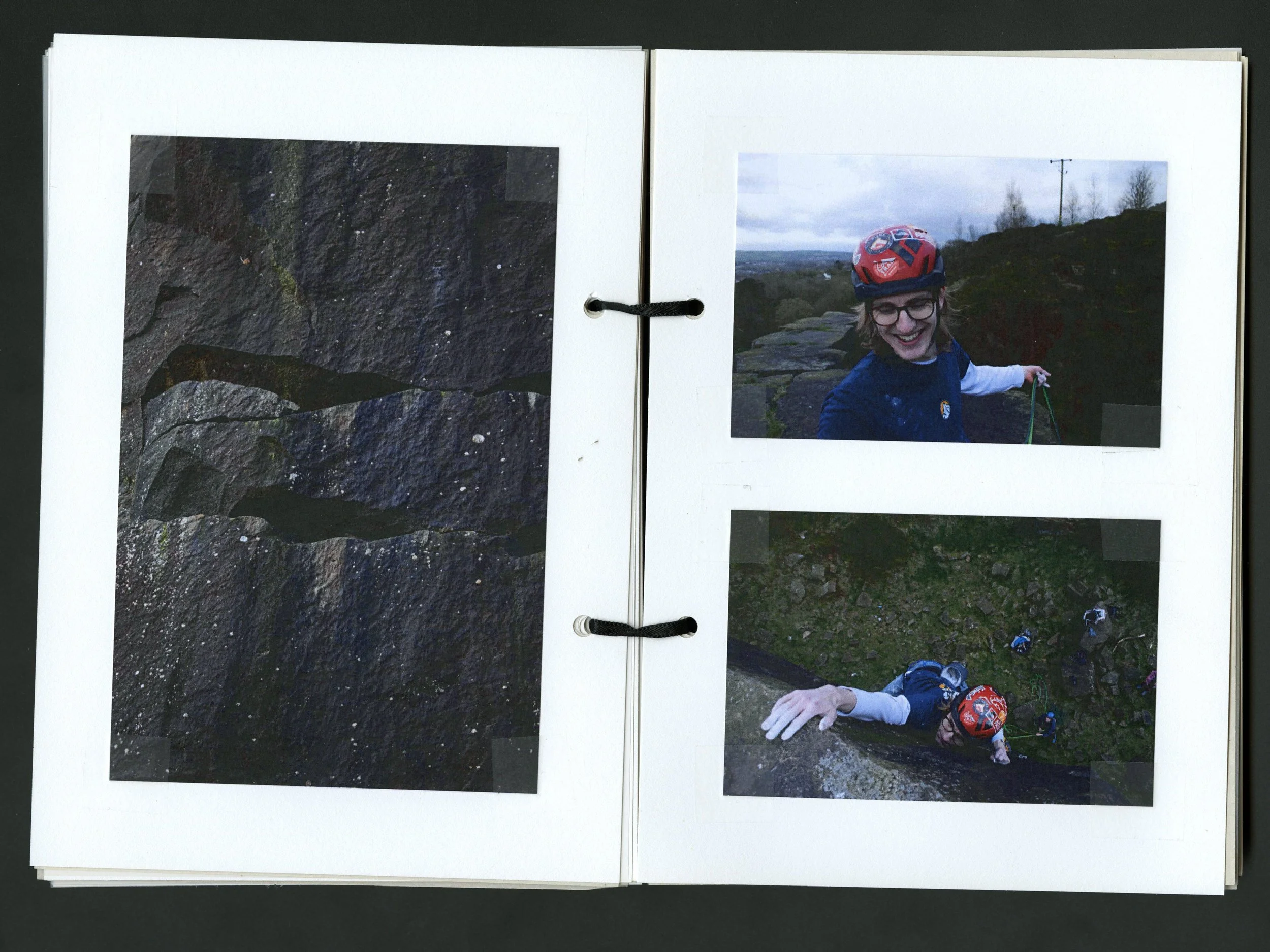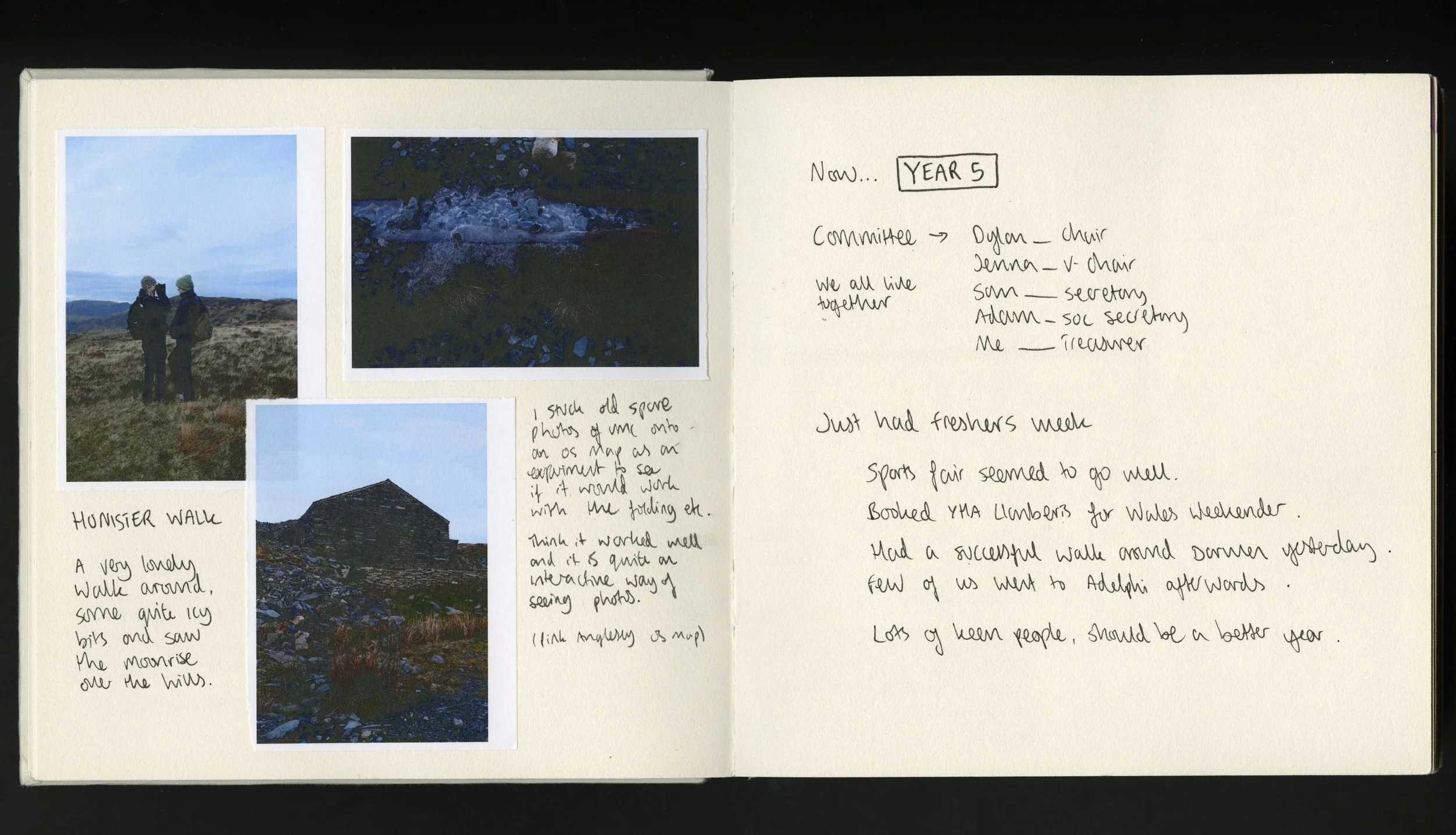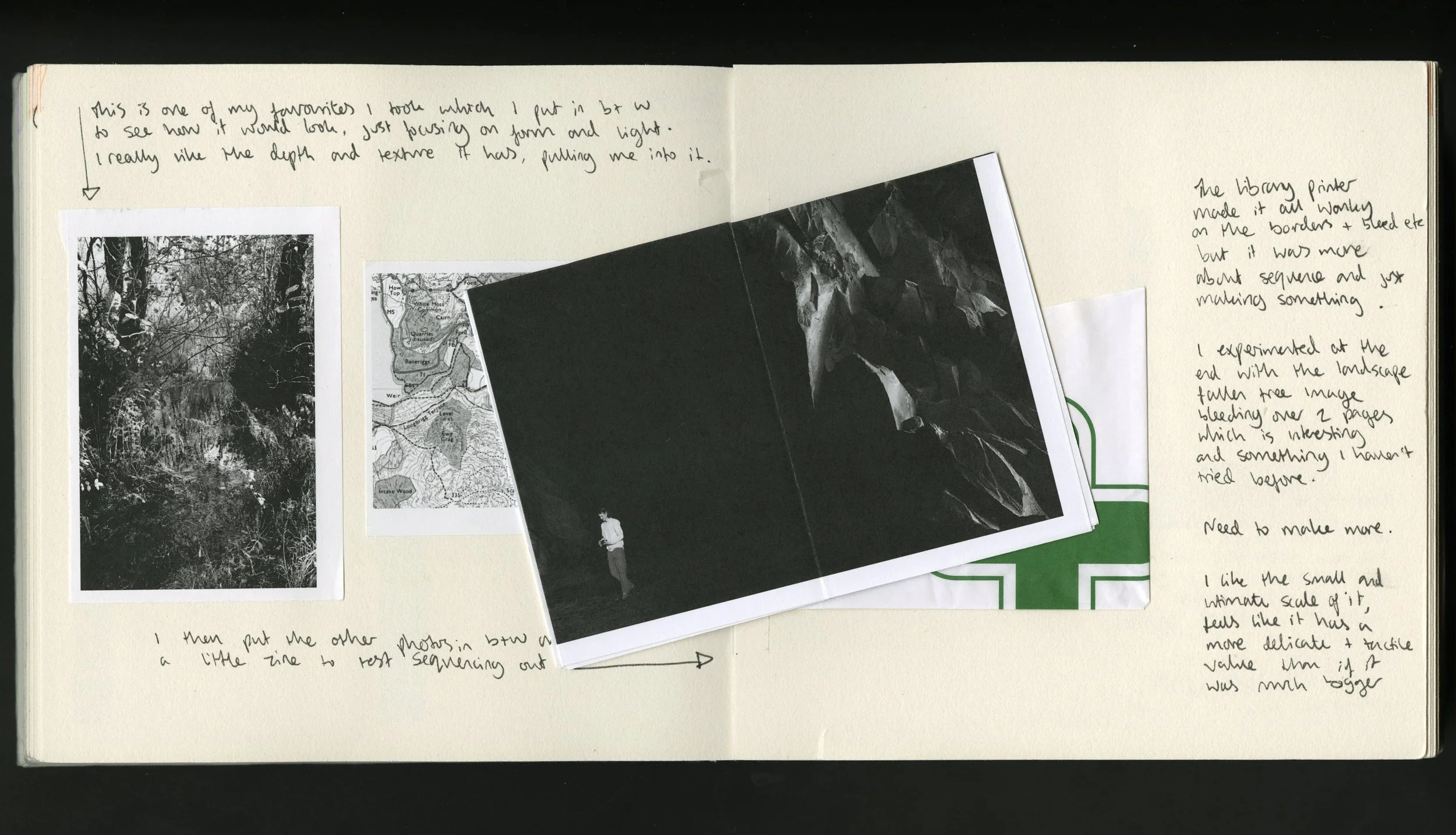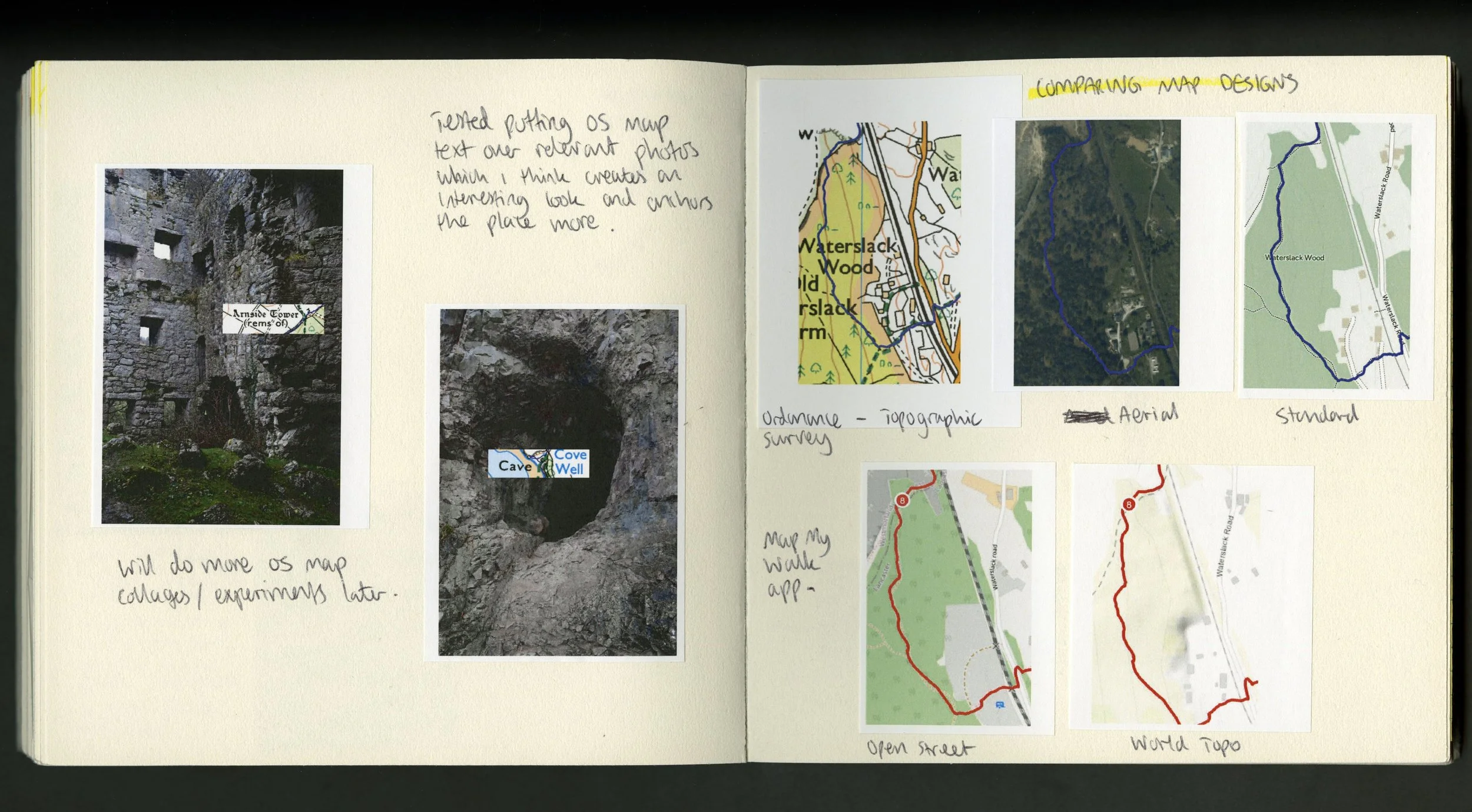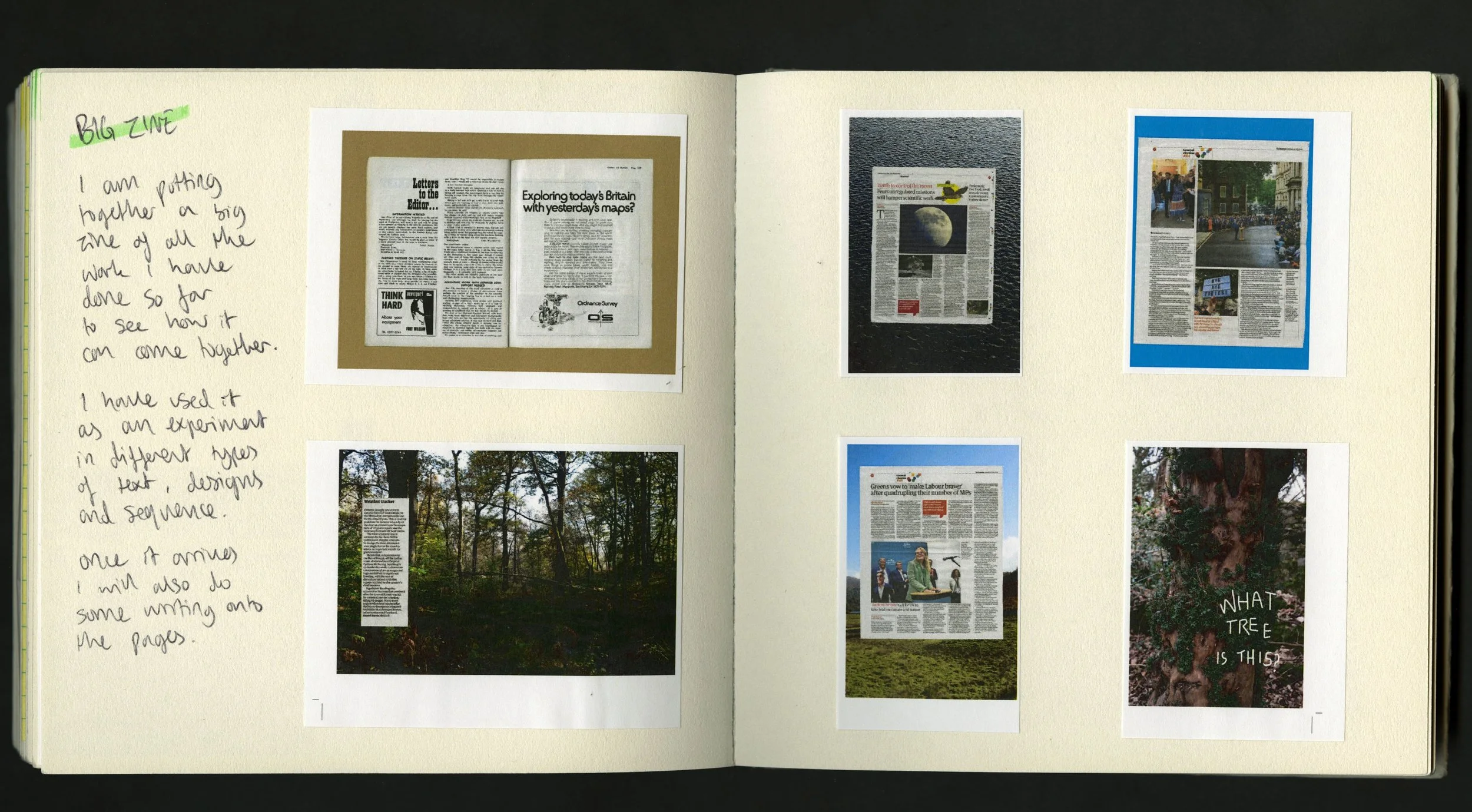PROJECT DEVELOPMENT
Last year
In 2024, before Landing got underway, I made a zine titled Notes on Cloud and Rock, which was a diaristic exploration of my university life, outdoor interests and the political context at the time.
Moving on from this, I wanted to make something that was less personally detailed and more refined, but still about my outdoor experiences and the context surrounding them…
The early stages of Landing
The project began around October 2024, and the initial idea was to make a project solely about the mountaineering club, which I was part of. I wanted to pay tribute to it and highlight the importance of having such communities, as the club and the opportunities it provided changed my life. I began by writing about my experience with the club so far, from when I joined in 2020 up to the start of my final year.
In the early phase of projects, I experiment and take lots of photos. The deeper conceptual grounding and aims of the work always tend to evolve later on.
I would photograph and document each club trip I went on, such as helping with this outdoor climbing taster day for freshers, at Anglezarke Quarry. I also interviewed club members about their experiences in the outdoors and the impact of the club, as well as their thoughts on the environmental/political context.
It was always vital to include other voices in the project and work to create some sort of dialogue, beyond my single voice. Over the course of making this body of work, I have realised the value of community in my life. Society feels increasingly disconnected from each other and the environment around us, and I think that community is essential in creating change and better ways of living. The mountaineering club has been my community for the last five years, and this project explores the power of going outside and reconnecting.
I also photographed personal walks or climbs, as club trips were not frequent enough to develop a project purely from these trips. The club didn’t end up being the sole focus, but one of the threads of the project, and without it there would have been no project at all. On my trips,
I began to take an interest in the history and the mapping out of places, such as Rydal Cave. I started making mini zines and narratives of the landscapes I had moved through.
The methodology was somewhat of an everyday, diaristic approach as these were not places I was going to specifically to make the project. Instead, the project expanded from my experiences in places that I would have been visiting regardless of this project. But it is through the project that I developed a more active engagement with these landscapes.
I tracked my movement on walks using my phone's GPS and made work that specifically responded to this, having become interested in psychogeography.
After a solo walk (the only walk of this project without any companions) around the Helm, a small hill in Oxenholme, I experimented with creating photo maps. I also made eight small zines from this walk, each exploring a different detail of the hill - the ground, the wall, the fell ponies, the gorse, the fungi, the tarn, the path and the history.
From this, I knew that the project would focus on mapping out the landscape and the various lives, details and complexities within and around it. I experimented with different map designs and collaged them onto the photos themselves.
A key turning point in the project was when I began reading Photography and Landscape by Rod Giblett and Juha Tolonen, which examines the often problematic nature of traditional landscape works.
It was here that I began to think about the array of problems often created or reinforced by much of traditional landscape photography. Among many complex issues, it is often a male, colonial and dominant view of the landscape that has created further separation between us and the land, as well as between each other. This has failed to engage with the land itself and the context surrounding it, presenting a static and distant viewpoint of an aestheticised, idealised landscape just to look at.
I decided that this project would challenge these issues and work to develop a deeper connection and engagement with the land and life around us.
Another influential text was Derek Gladwin’s Eco-Haptic Photography: Visualizing Irish Bogland in Rachel Giese’s ‘The Donegal Pictures’. Gladwin writes about using haptic visuality as a way to create more responsibility and care towards the environment.
Here, I traced the lines of movement from different walks and experimented with sewing a footpath line into this photo to create a more literal haptic experience. Part of the project challenging traditional landscape has been by showing movement through the landscape, not just photographing it from afar.
At the end of 2024 I hastily (and badly) put everything I had done over the previous couple of months together in a wiro bound zine. This let me test different design ideas, narratives and see how it came together, helping me reflect on the work so far, before refining it further next year.
This project slowly became a series of stories documenting haptic and communal experiences in the landscape, moving through and exploring the many interconnected layers within it.
I also began to realise the importance of text in this project, given that it’s about engaging more actively, accessing and learning about the landscape, creating a zine with just photos and blank pages would be pointless. The text anchors the ideas and aims of the work, arguably even more so than the photographs.
Work-in-progress exhibition
In Spring 2025, I put up a work-in-progress exhibition, which gave me a couple of months to refine the project and the direction it was heading. By this point, I had been to lots of different places, but chose just to exhibit my experience in Malham. This allowed me to go into the depth that was necessary to create an expanded conversation and challenge traditional landscape photography/display. It was also through this exhibition process that I got in touch with Adrian Kidd and Katharine Holmes, who contributed their local knowledge to the project. Some parts worked and some didn’t, but creating the exhibit showed me these parts and gave the project more conceptual grounding and a sense of place within the photographic context.









To accompany the research-based photowork on the wall, I also made a small A6 zine, A Pocket Guide to Landing, which presented the wider project and process of making the exhibition. The zine was printed by PRINT.WORK in Leeds, on Oribi Straw, a natural paper made from 100% recycled agricultural waste (products from crop farming which would otherwise be burnt).


















Final zine development
Over this summer, I have been bringing the project together in the form of four zines. I decided to do an exhibition at the end as well, so that people could physically access the zines for free, as I only printed a small run of copies. I have also become much more conscious of the materials and processes I am using, in order to minimise waste and the environmental impact of the project. For example, I have been using recycled paper made from post-consumer waste to print mock-ups at the library, trying to use less paper and materials that I already have. The main focus so far has been the paper usage, but there are still many things to learn and improvements to be made, such as the inks used, which I haven’t thoroughly explored yet.
I am also a lot more wary of making sure the zines don’t become just about my own recreation and privilege. Whilst the trips are recreational and I am privileged to have easier access to these places, I want to use my experiences as a way to help, inform and inspire other people, sharing the things I’ve learnt from them.
After assessing all the places I had photographed so far, I decided to move forward with Silverdale, Malham, Great Langdale and Dinorwig for the final zines. I thought that the depth of character, history and experiences within these places were most suited to be shared as a zine.
Zines are the way of making/sharing work that I enjoy the most and that suits my project the best. They are not single images, but multi-layered, research and movement-based narratives that I think only a printed zine can carry best.
Zines are also a more accessible way to make and share work than photobooks are, for example. Accessibility has become a very important part of my work, in relation to both the land and the project itself. Due to not being able to afford a large print run (making four different zines may have compromised this slightly), I have also done a local exhibition in an effort to increase access to the zines and project. As well as access, the exhibition will hopefully encourage community and discussion of the issues explored in Landing.
I began developing each zine by making printed mock-ups, to get a feel for how everything worked together and how best to develop and refine it.
I initially planned to handmake the zines, but after much consideration, I realised that this would require a lot more materials and resources, compared to sending it all off to Leeds to be printed and bound together. Having no prior binding experience or equipment, it would have also been riskier and more expensive. I will save handmaking for a future project…
Doing printed experiments allowed me to test and develop handwritten/drawn elements, which I could then scan and transfer to the digital edit.
I also decided to feature a longer piece of text in each zine, which discussed a specific contextual issue in more depth. Researching and writing these helped refine the ideas of the project further, especially in relation to the importance of our nature connectedness and the impact this can have on our environmental actions.
During the final, long period of refinement on InDesign, I went through the narrative of each zine and checked them against the main project aims - knowing nature and the land, developing care and challenging traditional landscape photography.
After receiving the printed zines, the final task was to add the handwritten notes and tape labels. I felt these parts were best added onto the zine itself to create a more reflective, haptic and engaged narrative, guided by a stream of consciousness.
I documented the summer development in more detail on a Substack blog.
